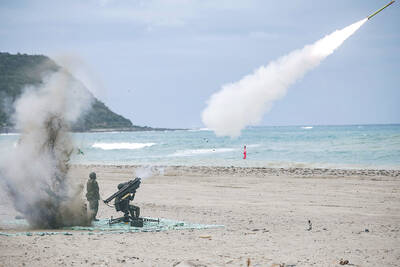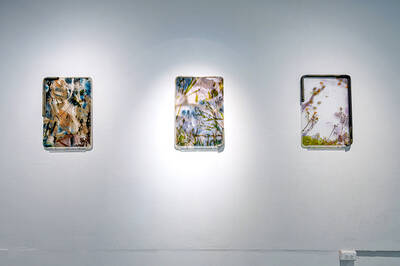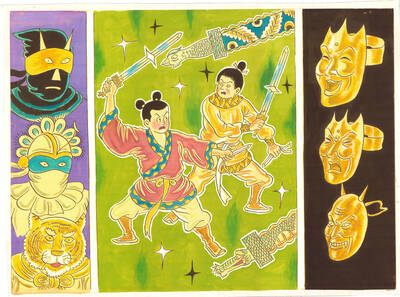On a September night 15 years ago I sat in the National Theater and was blown away by U-Theatre’s (優人神鼓) River Journey (與你共舞).
One of my sisters sat next to me, and she still ranks the show as one of the all-time highlights of her stays in Taiwan.
As I, and many others, have said, one of the many benefits about being in Taiwan during the COVID-19 pandemic is not only that theaters and other entertainment venues have been largely able to stay open this year, but local companies, unable to fulfil their international travel commitments, have had the time to revive or restage some of their classic works.

Photo courtesy of U Theatre
For the famed Zen percussion group, that has meant a revival of River Journey, which premiered on Sept. 21, 2006, and which returns to the National Theater on Friday next week, making it the perfect Christmas present for U-Theatre fans.
The piece was inspired by poetry written by musical director Huang Chih-chun (黃誌群) during a trip to India in 2001, his fourth to that nation, which included a visit to Lumbini, the birthplace of Siddhartha Gautama, the Buddha.
He wrote the poems, many of them in stream of consciousness form, about the people he met and his experiences, as well as his reflections on the company. He sent them to his wife, U-Theatre founder-director Liu Ruo-yu (劉若瑀), and other members of the company.

Photo courtesy of U Theatre
For Huang, the trip reinforced the idea that concentrating on living in the moment was key, something that he, Liu and other company members have sought to practice in their mediation and training, as well as performances.
“We decided to make this India journey, these poems, into a performance — each dance comes from a poem,” Liu told me in an interview ahead of the 2006 premiere.
Liu and Huang also saw an opportunity to utilize their interest in Gurdjieff’s Sacred Dances by putting the techniques into the core of the new work.
Georges Gurdjieff, the Russian philosopher and mystic, created what became known as Gurdjieff Movements, a combination of exercises, meditation concentration and music that were based on traditional and sacred dances that he saw during his travels in the early years of the 20th century through Central Asia, including Sufi and Buddhist traditions.
Luo and Huang first encountered the dances during a visit to the Osho meditation center in Pune, India, and began to incorporate the movements into their martial arts and drumming practices in the mid-1990s.
The Chinese title of River Journey — Yu ni gong wu — can be translated literally as “dancing with you,” and was taken from the final line in one of Huang’s poems, where he described the feeling of turning around to feel heaven and earth dancing with him.
The images of U-Theatre members spinning in the final segment of River Journey, much like Sufi dervishes, the tails of their long tunics flying out around them as they are gradually joined by other performers until the stage of the National Theater becomes a sea of swirling bodies, ranks as one of the most memorable climaxes of any show I have ever seen.
The fluid garments were created by Oscar-winning designer Tim Yip (葉錦添), one of the company’s frequent collaborators, while the stage and lighting were designed by Lin Keh-hua (林克華), with videos by Ethan Wang (王奕盛).
River Journey runs approximately 75 minutes, and tickets for the Taipei shows have been selling fast.
However, do not despair. If you miss out on the National Theater performances, the company is taking the show to the National Taichung Theater in the middle of March and the National Kaohsiung Center for the Arts in April, and there are still plenty of tickets left for those performances.

In late October of 1873 the government of Japan decided against sending a military expedition to Korea to force that nation to open trade relations. Across the government supporters of the expedition resigned immediately. The spectacle of revolt by disaffected samurai began to loom over Japanese politics. In January of 1874 disaffected samurai attacked a senior minister in Tokyo. A month later, a group of pro-Korea expedition and anti-foreign elements from Saga prefecture in Kyushu revolted, driven in part by high food prices stemming from poor harvests. Their leader, according to Edward Drea’s classic Japan’s Imperial Army, was a samurai

Located down a sideroad in old Wanhua District (萬華區), Waley Art (水谷藝術) has an established reputation for curating some of the more provocative indie art exhibitions in Taipei. And this month is no exception. Beyond the innocuous facade of a shophouse, the full three stories of the gallery space (including the basement) have been taken over by photographs, installation videos and abstract images courtesy of two creatives who hail from the opposite ends of the earth, Taiwan’s Hsu Yi-ting (許懿婷) and Germany’s Benjamin Janzen. “In 2019, I had an art residency in Europe,” Hsu says. “I met Benjamin in the lobby

April 22 to April 28 The true identity of the mastermind behind the Demon Gang (魔鬼黨) was undoubtedly on the minds of countless schoolchildren in late 1958. In the days leading up to the big reveal, more than 10,000 guesses were sent to Ta Hwa Publishing Co (大華文化社) for a chance to win prizes. The smash success of the comic series Great Battle Against the Demon Gang (大戰魔鬼黨) came as a surprise to author Yeh Hung-chia (葉宏甲), who had long given up on his dream after being jailed for 10 months in 1947 over political cartoons. Protagonist

A fossil jawbone found by a British girl and her father on a beach in Somerset, England belongs to a gigantic marine reptile dating to 202 million years ago that appears to have been among the largest animals ever on Earth. Researchers said on Wednesday the bone, called a surangular, was from a type of ocean-going reptile called an ichthyosaur. Based on its dimensions compared to the same bone in closely related ichthyosaurs, the researchers estimated that the Triassic Period creature, which they named Ichthyotitan severnensis, was between 22-26 meters long. That would make it perhaps the largest-known marine reptile and would